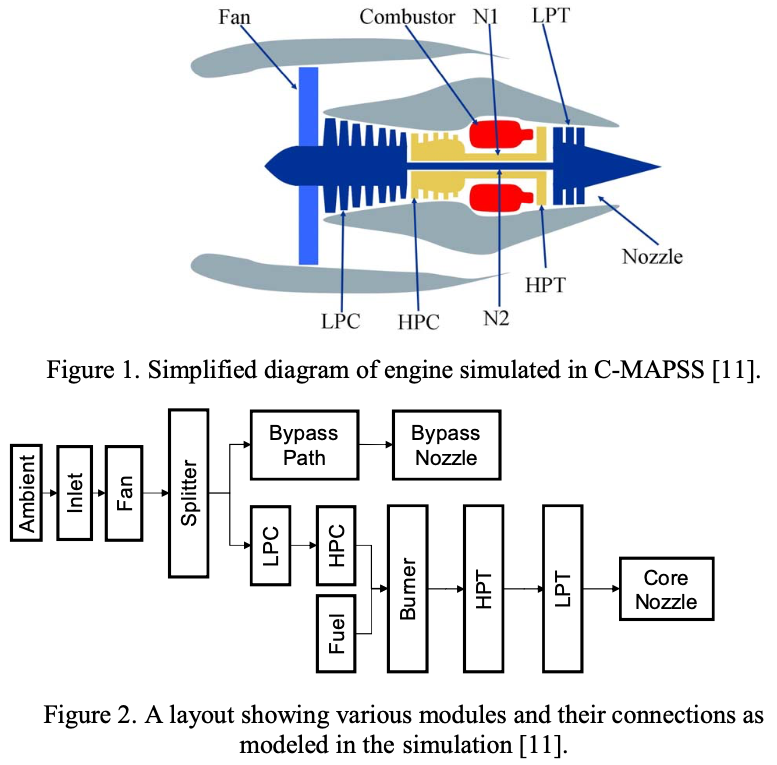Prognostics and health management is an important topic in industry for predicting state of assets to avoid downtime and failures. Public data set for asset degradation modeling from NASA which includes run-to-failure simulated data from turbo fan jet engines is used for prediction of remaining useful life (RUL) of the engines.
- A. Saxena and K. Goebel (2008). “Turbofan Engine Degradation Simulation Data Set”, NASA Ames Prognostics Data Repository, NASA Ames Research Center, Moffett Field, CA
- Engine degradation simulation was carried out using C-MAPSS (Commercial Modular Aero-Propulsion System Simulation). Four different sets were simulated under different combinations of operational conditions and fault modes. Records several sensor channels to characterize fault evolution. The data set was provided by the Prognostics CoE at NASA Ames.

- Engine’s five rotating components: Fan, LPC, HPC (High-Pressure Compressor), HPT (High-Pressure Turbine), LPT
- Gas path: HPC, HPT, LPT
- Operational settings: altitude, throttle resolver angle (TRA), Mach number
- The time series (cycles) of sensed measurements typically available from aircraft gas turbine engines.
| Symbol | Description | Units |
|---|---|---|
| T2 | Total temperature at fan inlet | oR |
| T24 | Total temperature at LPC outlet | oR |
| T30 | Total temperature at HPC outlet | oR |
| T50 | Total temperature at LPT outlet | oR |
| P2 | Pressure at fan inlet | psia |
| P15 | Total pressure in bypass-duct | psia |
| P30 | Total pressure at HPC outlet | psia |
| Nf | Physical fan speed | rpm |
| Nc | Physical core speed | rpm |
| epr | Engine pressure ratio (P50/P2) | – |
| Ps30 | Static pressure at HPC outlet | psia |
| phi | Ratio of fuel flow to Ps30 | pps/psi |
| NRf | Corrected fan speed | rpm |
| NRc | Corrected core speed | rpm |
| BPR | Bypass Ratio | – |
| farB | Burner fuel-air ratio | – |
| htBleed | Bleed Enthalpy | – |
| Nf_dmd | Demanded fan speed | rpm |
| PCNfR_dmd | Demanded corrected fan speed | rpm |
| W31 | HPT coolant bleed | lbm/s |
| W32 | LPT coolant bleed | lbm/s |
a) check input variables
def read_data(path):
df = pd.read_csv(path, delimiter=' ', header=None)
# check null ratios of each columns
rc = df.isnull().sum(axis=0)/len(df)
print(rc[rc!=0.])
return df
names = ['unit', 'time',
'altitude', 'mach', 'TRA',
'T2', 'T24', 'T30', 'T50', 'P2', 'P15', 'P30', 'Nf', 'Nc', 'epr',
'Ps30', 'phi', 'NRf', 'NRc', 'BPR', 'farB', 'htBleed', 'Nf_dmd', 'PCNfR_dmd', 'W31', 'W32']
df_train = read_data('CMAPSSData/train_FD001.txt')
# remove full of null columns
df_train.drop([26, 27], axis=1, inplace=True)
df_train.columns = names
def inspect_variables(df, unit=None, pdf=None):
names = df.columns
nrow = 5
ncol = 5
idx = 0
fig, axes = plt.subplots(nrow, ncol, constrained_layout=True)
for ii in range(nrow):
for jj in range(ncol):
idx = ii*nrow+jj+5
axes[ii,jj].plot(df[names[idx]][df.unit==unit], marker='o', markersize=1, linewidth=0)
axes[ii,jj].set_xlabel('{}'.format(names[idx]), fontsize=8)
if idx==25: break
fig.suptitle('unit = {}: sensor readings as time series'.format(unit))
pdf.savefig()
plt.close()
fig, axes = plt.subplots(nrow, ncol, constrained_layout=True)
for ii in range(nrow):
for jj in range(ncol):
idx = ii*nrow+jj+5
axes[ii,jj].hist(df[names[idx]][df.unit==unit], bins=20)
axes[ii,jj].set_xlabel('{}'.format(names[idx]), fontsize=8)
if idx==25: break
fig.suptitle('unit = {}: sensor readings as histogram'.format(unit))
pdf.savefig()
plt.close()
nrow = 2
ncol = 3
fig, axes = plt.subplots(nrow, ncol, constrained_layout=True)
for ii in range(ncol):
name = names[ii+nrow]
axes[0,ii].plot(df[name][df.unit==unit], marker='o', markersize=1, linewidth=0)
axes[0,ii].set_xlabel('time vs {}'.format(name), fontsize=8)
axes[1,ii].hist(df[name][df.unit==unit], bins=20)
axes[1,ii].set_xlabel('{} (histogram)'.format(name), fontsize=8)
fig.suptitle('unit = {}: operational settings'.format(unit))
pdf.savefig()
plt.close()
from matplotlib.backends.backend_pdf import PdfPages
with PdfPages('input.pdf') as pdf:
inspect_variables(df_train, unit=1, pdf=pdf)
